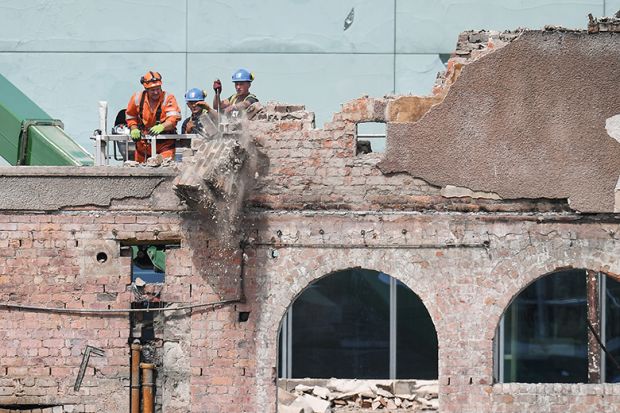Since flames tore through the Glasgow School of Art’s Charles Rennie Mackintosh-designed home, a national conversation is ongoing about whether the celebrated building should be rebuilt.
“Mackintosh’s Glasgow School of Art is gone,” explained Glasgow-based architect Alan Dunlop on the “irreparable” damage to the iconic Sauchiehall Street structure. Experts have put the cost of rebuilding the ravaged “Mack” at £100 million, while design guru Stephen Bayley argued that an innovative new design would be preferable to a “lame duck reproduction”. Meanwhile, The Times’ letters pages have been filled with calls to restore the celebrated building at any cost, a view endorsed by many Glaswegians and supporters across the world.
The overwhelming concern for the future of the Mackintosh indicates that it is not just another university building, said Tom Inns, the art school’s director.
“It’s understandable because so many people have a relationship with it – students, staff and residents of Glasgow love it, while others have a link through the work of Mackintosh,” he told Times Higher Education.
“It’s always been an incredible building, not just because it was designed for a purpose or the activity that has taken place within it – it’s a combination of the two.”
Professor Inns had just returned home from a graduation ceremony and was sitting with a cup of cocoa when he heard the news of the fire, which struck just months before a £32 million restoration was due to be completed following a blaze in 2014.
“This fire has had a much bigger impact on the school than it did in 2014,” said Professor Inns, who had just taken over the school when the first fire hit.
Some 60 local residents evacuated from nearby homes still have nowhere to live, while the fire also spread to the O2 ABC music venue, delivering a huge blow to local businesses. Sections of Sauchiehall Street are now closed off while parts of the Mack are dismantled, Inns explained. “It’s normally a very lively street,” he said.
Professor Inns has, however, confirmed that the Mack will be rebuilt. “It is as vital a part of the Glasgow School of Art’s future as it has been for the past 100 years,” he said, adding that the Mack would “continue to provide creative inspiration to students, staff and visitors”.
“The Mackintosh Building will be rebuilt and will be a working art school,” he insisted, adding that “we have never underestimated its importance in terms of influencing the creative practice of those who work in it, nor the affection in which it is held by Glasgow.”
It is too soon to say when the Mack might return (“as quickly as possible”, said Professor Inns), with contractors still assessing the extent of the damage, but attention is now firmly on ensuring that university life continues as smoothly as possible for students. While the Mack itself had not yet been returned to action following the 2014 fire, the visitor centre, shop and exhibition spaces at its nearby Reid building have been closed, as have other teaching spaces.
“We’re expecting a very different and busy summer,” admitted Professor Inns of the extra work needed to secure alternative space and technical equipment so that studies are not interrupted.
“We have about 400 postgraduates who will want to study through to summer and about 1,500 open studio students here in the summer months, so we’ve been looking at keeping continuity without two of our core buildings,” he said.
With exhibition space containing student work cordoned off for weeks, the school’s 400 staff have already had to get creative to mitigate the impact on students, Professor Inns added.
“The majority of student work due to go down to the London design shows was inaccessible, but we managed to provide some form of exhibition by using digital images of their work,” he explained. “It wasn’t the same as the real thing, but at least students had a presence there.”
“This is a really big thing for a small institution to handle, but we are pulling together,” Professor Inns continued, adding that he was also “mindful of staff fatigue and how we support staff as we are losing the summer” normally spent on research and teaching preparations.
Questions about how the fire started have still yet to be answered, although Inns pointed out that new sprinklers were not working “because they were being installed” when the blaze broke out. “The building had not been handed back to us and we’d received the assurances you’d expect,” he said.
Whether another multimillion-pound fundraising campaign is needed – the last one was backed by Hollywood actor Brad Pitt – is unclear, but Professor Inns was confident that existing insurance will cover it. “It will require a lot of resource, but that is why you have full building insurance,” he said.
POSTSCRIPT:
Print headline: Glasgow School of Art aims for normality in extraordinary times
Register to continue
Why register?
- Registration is free and only takes a moment
- Once registered, you can read 3 articles a month
- Sign up for our newsletter
Subscribe
Or subscribe for unlimited access to:
- Unlimited access to news, views, insights & reviews
- Digital editions
- Digital access to THE’s university and college rankings analysis
Already registered or a current subscriber?







